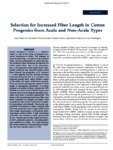Use este identificador para citar ou linkar para este item:
http://www.alice.cnptia.embrapa.br/alice/handle/doc/1041554Registro completo de metadados
| Campo DC | Valor | Idioma |
|---|---|---|
| dc.contributor.author | CARVALHO, L. P. de | pt_BR |
| dc.contributor.author | FARIAS, F. J. C. | pt_BR |
| dc.contributor.author | RODRIGUES, J. I. DA S. | pt_BR |
| dc.date.accessioned | 2016-03-21T11:11:11Z | pt_BR |
| dc.date.available | 2016-03-21T11:11:11Z | pt_BR |
| dc.date.created | 2016-03-21 | pt_BR |
| dc.date.issued | 2015 | pt_BR |
| dc.identifier.citation | Crop Science, v. 55, p. 1-7, May./June 2015. | pt_BR |
| dc.identifier.issn | 0011-183X | pt_BR |
| dc.identifier.uri | http://www.alice.cnptia.embrapa.br/alice/handle/doc/1041554 | pt_BR |
| dc.description | Cotton (Gossypium hirsutum L. r. latifolium Hutch.) is one of the crops of greatest economic importance in Brazil. The changes in weaving technology, competition with synthetic fibers, and the globalization of cotton and textile production have increased the demand for better quality fibers. One of the characteristics to be improved is fiber length. Brazil traditionally produced and exported longer cotton fibers through the production of G. hirsutum L. r. marie galante, but this race has not been produced during the last 10 yr because of its perennial growth habit, which hinders control of the cotton boll weevil, Anthonomus grandis. This work studied some genetic aspects of fiber length in segregating generations of crosses between two upland cultivars, Guazuncho 2 (PI 606819) and Acala SJ4 (PI 529538). Single-seed descent protocol and pedigree breeding procedures were used to advance generations. The fibers of the recombinant inbred lines (RILs) and those originated by pedigree procedure were evaluated by high-volume instrument for length, lint percentage, and strength. The results suggest that it is possible to select materials with improved upper-half mean length (UHML) that have values approaching a commercial extralong staple upland cultivar. A high percentage of the RILs also exhibited a UHML greater than 32 mm. Genetic gain for fiber length from the F4 to the F5 generation was 6.8%, indicating significant variability for UHML. The result indicates that simple methods of intrapopulational breeding may lead to genetic gains in UHML. | pt_BR |
| dc.language.iso | eng | eng |
| dc.rights | openAccess | eng |
| dc.subject | Textile production | pt_BR |
| dc.title | Selection for increased fiber length in cotton progenies from Acala and Non-Acala types. | pt_BR |
| dc.type | Artigo de periódico | pt_BR |
| dc.date.updated | 2017-03-09T11:11:11Z | pt_BR |
| dc.subject.thesagro | Algodão | pt_BR |
| dc.subject.thesagro | Gossypium hirsutum | pt_BR |
| dc.subject.thesagro | Fibra | pt_BR |
| dc.subject.thesagro | Anthonomus Grandis | pt_BR |
| dc.subject.nalthesaurus | cotton | pt_BR |
| riaa.ainfo.id | 1041554 | pt_BR |
| riaa.ainfo.lastupdate | 2017-03-09 | pt_BR |
| dc.contributor.institution | LUIZ PAULO DE CARVALHO, CNPA; FRANCISCO JOSE CORREIA FARIAS, CNPA; JOSIANE ISABELA DA SILVA ROFRIGUES, CNPA. | pt_BR |
| Aparece nas coleções: | Artigo em periódico indexado (CNPA)  | |
Arquivos associados a este item:
| Arquivo | Descrição | Tamanho | Formato | |
|---|---|---|---|---|
| Selectionforincreasedfiberlengthincotton....pdf | 607,49 kB | Adobe PDF |  Visualizar/Abrir |









